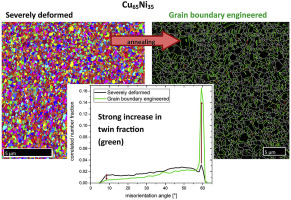当前位置:
X-MOL 学术
›
Acta Mater.
›
论文详情
Our official English website, www.x-mol.net, welcomes your
feedback! (Note: you will need to create a separate account there.)
Grain boundary engineering parameters for ultrafine grained microstructures: Proof of principles by a systematic composition variation in the Cu-Ni system
Acta Materialia ( IF 8.3 ) Pub Date : 2018-05-01 , DOI: 10.1016/j.actamat.2018.02.054 Friederike Emeis , Martin Peterlechner , Sergiy V. Divinski , Gerhard Wilde
Acta Materialia ( IF 8.3 ) Pub Date : 2018-05-01 , DOI: 10.1016/j.actamat.2018.02.054 Friederike Emeis , Martin Peterlechner , Sergiy V. Divinski , Gerhard Wilde

|
Abstract The main principles of grain boundary engineering of an ultrafine grained microstructure are studied via a systematic variation of the stacking fault energy ( γ S F E ), solid solution effects (SSEs) and the homologous deformation/annealing temperatures choosing the Cu-Ni system as a model case for non-segregating alloys. Cu and Ni are completely miscible and the γ S F E varies strongly with the alloy composition. Ultrafine grained microstructures are produced by high-pressure torsion and their evolution upon annealing is investigated. The thermal stability and the saturation grain sizes after deformation are determined by SSEs. The fraction of deformation twins varies in accordance with the γ S F E . The increase of the length fraction of Σ 3 grain boundaries versus the grain size is found to be governed by the SSEs, whereas the increase of the length fraction of Σ 9 grain boundaries versus the grain size depends on the γ S F E . The results indicate that grain boundary engineering may lead to an optimum ultrafine grained structure, i.e. with a high length fraction of Σ 3 and Σ 9 grain boundaries of approximately 40%. This is a significantly large fraction in comparison to a not-engineered microstructure and achieved for grain sizes below 1000 nm in alloys close to the equiatomic composition having a low γ S F E and a high melting temperature. This high fraction of Σ 3n grain boundaries (including their conjunctions) proved itself most effective for microstructure stabilization in this virtually non-segregating system. Thus, for Cu50Ni50 and Cu65Ni35, a narrow grain size distribution of small grains, a high hardness and a high fraction of special grain boundaries can be adjusted.
中文翻译:

超细晶粒微结构的晶界工程参数:通过 Cu-Ni 系统中系统成分变化的原理证明
摘要 通过选择 Cu-Ni 系统作为堆垛层错能 (γSFE)、固溶效应 (SSE) 和同系变形/退火温度的系统变化,研究了超细晶粒显微组织晶界工程的主要原理。非偏析合金的模型案例。Cu 和 Ni 完全混溶,γ SFE 随合金成分变化很大。超细晶粒微结构是通过高压扭转产生的,并研究了它们在退火时的演变。变形后的热稳定性和饱和晶粒尺寸由 SSE 决定。变形孪晶的比例根据γ SFE 变化。发现 Σ 3 晶界长度分数与晶粒尺寸的增加受 SSE 控制,而 Σ 9 晶界长度分数相对于晶粒尺寸的增加取决于 γ SFE 。结果表明,晶界工程可能导致最佳的超细晶粒结构,即具有大约 40% 的 Σ 3 和 Σ 9 晶界的高长度分数。与非工程微观结构相比,这是一个非常大的比例,并且在接近等原子组成的合金中实现的晶粒尺寸低于 1000 nm,具有低 γ SFE 和高熔化温度。这种高比例的 Σ 3n 晶界(包括它们的连接点)证明在这个几乎非偏析的系统中对微观结构稳定最有效。因此,对于 Cu50Ni50 和 Cu65Ni35,小晶粒的窄晶粒尺寸分布,
更新日期:2018-05-01
中文翻译:

超细晶粒微结构的晶界工程参数:通过 Cu-Ni 系统中系统成分变化的原理证明
摘要 通过选择 Cu-Ni 系统作为堆垛层错能 (γSFE)、固溶效应 (SSE) 和同系变形/退火温度的系统变化,研究了超细晶粒显微组织晶界工程的主要原理。非偏析合金的模型案例。Cu 和 Ni 完全混溶,γ SFE 随合金成分变化很大。超细晶粒微结构是通过高压扭转产生的,并研究了它们在退火时的演变。变形后的热稳定性和饱和晶粒尺寸由 SSE 决定。变形孪晶的比例根据γ SFE 变化。发现 Σ 3 晶界长度分数与晶粒尺寸的增加受 SSE 控制,而 Σ 9 晶界长度分数相对于晶粒尺寸的增加取决于 γ SFE 。结果表明,晶界工程可能导致最佳的超细晶粒结构,即具有大约 40% 的 Σ 3 和 Σ 9 晶界的高长度分数。与非工程微观结构相比,这是一个非常大的比例,并且在接近等原子组成的合金中实现的晶粒尺寸低于 1000 nm,具有低 γ SFE 和高熔化温度。这种高比例的 Σ 3n 晶界(包括它们的连接点)证明在这个几乎非偏析的系统中对微观结构稳定最有效。因此,对于 Cu50Ni50 和 Cu65Ni35,小晶粒的窄晶粒尺寸分布,











































 京公网安备 11010802027423号
京公网安备 11010802027423号